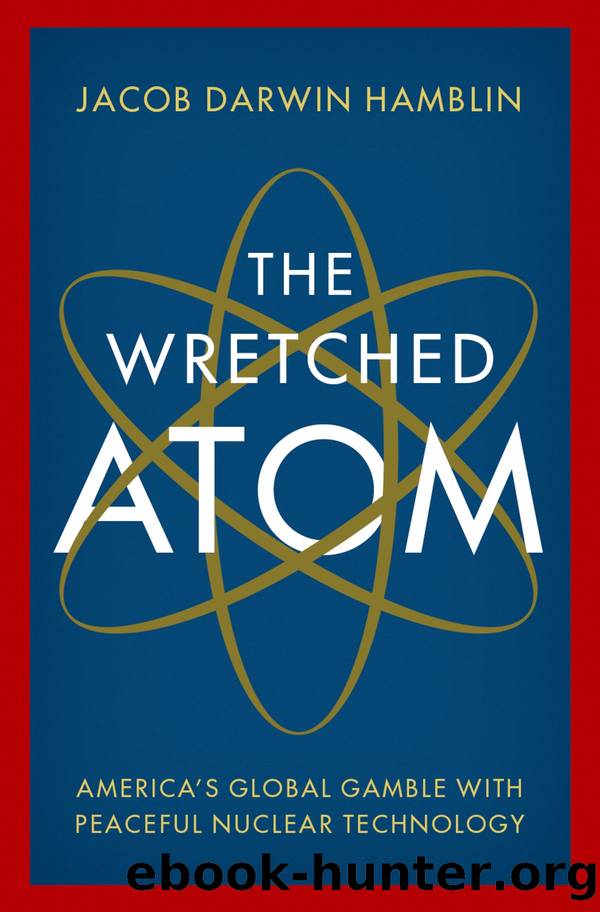The Wretched Atom by Jacob Darwin Hamblin

Author:Jacob Darwin Hamblin
Language: eng
Format: epub
Publisher: Oxford University Press
Published: 2021-01-15T00:00:00+00:00
CHAPTER 7
Nuclear Mosques and Monuments
The summer of 1974 was a season of angry Canadians, and Indian foreign secretary Kewal Singh felt its full force on a diplomatic visit to Ottawa in July. Newspapers abused him and Canadian officials berated him for what they saw as a betrayal of trust and a threat to world peace. From one Commonwealth nation to another, the conversations had the air of a sibling rivalry. For years, Canada and others had provided food aid and technical assistance to India, and Canada in particular had helped with nuclear reactors for electricity generation. In the past half-decade, the IAEA had upheld India as the symbol of atomic energy in the developing world, with its mutation plant breeding program. But India had done the unthinkableâand to some, unforgivableâby detonating an atomic explosive. Singh and other Indian officials insisted it was a peaceful one, like the ones promoted by the US Atomic Energy Commission. It was dubbed the Smiling Buddha, but the Canadians were not amused. For Singh, it was an exhausting visit to Canada, during which he had been treated to hostile criticism, threats to halt assistance, and embittered lectures about his nationâs world responsibilities.1
When the visit ended, Singh and his diplomatic entourage went on to Washington for some frank discussions at the US State Department. There he met with Henry Kissinger, who was having a bad summer, as President Richard Nixon was embroiled in controversy about illegal conduct in the Watergate scandal. Over the previous week, the US House of Representatives had adopted three articles of impeachment against Nixon, creating an aura of intense stress and tumult in Washington (Kissinger, ever the diplomat, simply referred to it as an âunsettled situationâ to Singh; the president resigned a week later). If this were not enough to make diplomatic conversations a challenge, Kissinger was suffering from a painful in-grown toenail, only recently cut by a doctor. When Singh met with Kissinger on August 2, the secretary of state sat with his foot up on the table. Singh, who had been treated as an uppity stepchild by the Canadians in Ottawa, had to view Kissingerâs foot as the two men discussed Indiaâs new place in the world.
âI donât believe in recriminations about past events,â Kissinger stated to Singh, according to an official memorandum of conversation. âBut I have wondered about the following. Intellectually, a peaceful nuclear explosion has a different meaning and significance for a developing country than it has for an advanced country.â It is difficult to imagine a more candid statement of Kissingerâs view of Indiaâs place, or a more explicit acknowledgment of the double standard in Kissingerâs mind about nuclear technologies. Singhâs noncommittal answer is recorded as simply âYes?â Kissinger then softened his statement, saying he meant only that advanced countries could control explosions with precision, whereas developing countries could not.2 He could not muster a stronger condemnation.
The test of the Smiling Buddha is typically seen as a fulcrum point in nuclear affairs, with the world growing more skeptical of the connections between economic uplift and nuclear programs in poor countries.
Download
This site does not store any files on its server. We only index and link to content provided by other sites. Please contact the content providers to delete copyright contents if any and email us, we'll remove relevant links or contents immediately.
Phoenicians among Others: Why Migrants Mattered in the Ancient Mediterranean by Denise Demetriou(577)
Verus Israel: Study of the Relations Between Christians and Jews in the Roman Empire, AD 135-425 by Marcel Simon(576)
Caesar Rules: The Emperor in the Changing Roman World (c. 50 BC â AD 565) by Olivier Hekster(558)
Europe, Strategy and Armed Forces by Sven Biscop Jo Coelmont(504)
american english file 1 student book 3rd edition by Unknown(481)
Give Me Liberty, Seventh Edition by Foner Eric & DuVal Kathleen & McGirr Lisa(469)
Banned in the U.S.A. : A Reference Guide to Book Censorship in Schools and Public Libraries by Herbert N. Foerstel(467)
The Roman World 44 BC-AD 180 by Martin Goodman(458)
Reading Colonial Japan by Mason Michele;Lee Helen;(457)
Basic japanese A grammar and workbook by Unknown(456)
DS001-THE MAN OF BRONZE by J.R.A(443)
The Dangerous Life and Ideas of Diogenes the Cynic by Jean-Manuel Roubineau(440)
Introducing Christian Ethics by Samuel Wells and Ben Quash with Rebekah Eklund(433)
Imperial Rome AD 193 - 284 by Ando Clifford(432)
The Oxford History of World War II by Richard Overy(432)
Literary Mathematics by Michael Gavin;(392)
Language Hacking Mandarin by Benny Lewis & Dr. Licheng Gu(380)
Catiline by Henrik Ibsen--Delphi Classics (Illustrated) by Henrik Ibsen(369)
How to Reach the 9.0 in IELTS Academic Reading by IELTS Medical(358)
